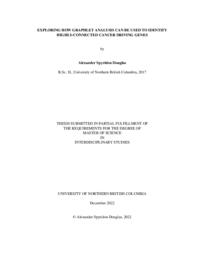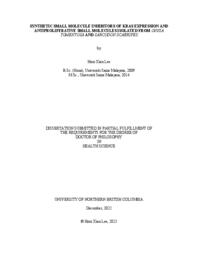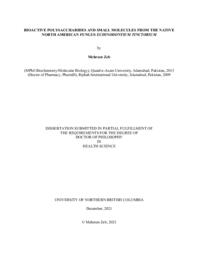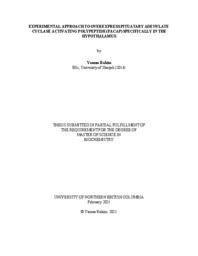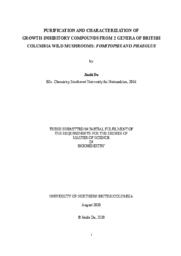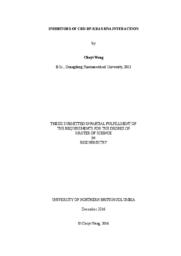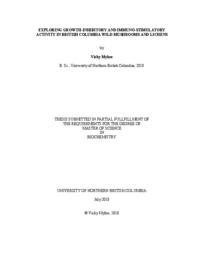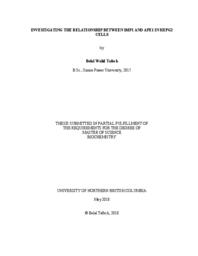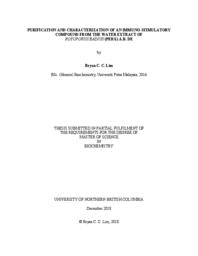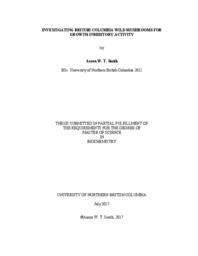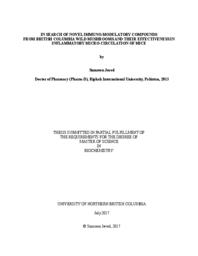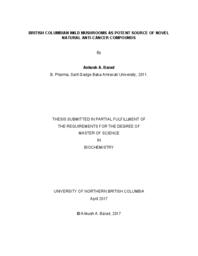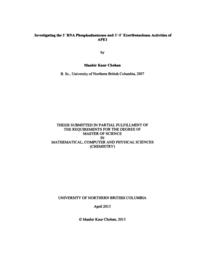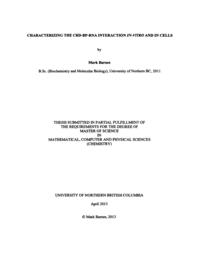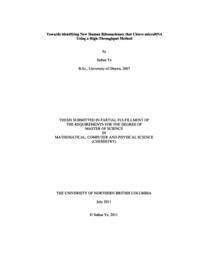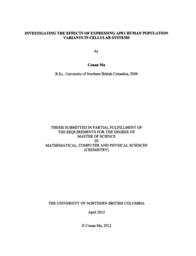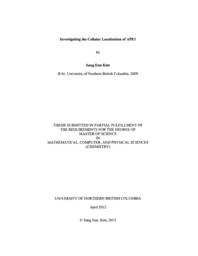Lee, Chow
Person Preferred Name
Chow Lee
Related Works
Content type
Digital Document
Origin Information
Content type
Digital Document
Origin Information
Content type
Digital Document
Description / Synopsis
Acetylcholinesterase is a hydrolase enzyme known for its major role in neurotransmission regulation by breaking down the neurotransmitter acetylcholine at the synapse after every electrochemical signal is successfully relayed between two adjacent neurons. In a healthy human brain, it retains itself on the extracellular surface of neurons, concordantly paints up an artistic beautiful web of an intricate neural network upon staining. However, in an aging human brain experiencing neurodegeneration, the network collapses into plaques that are neurotoxic to the brain. At the center of these individual plaques are heavily aggregated amyloid-beta peptides and fibers enveloping the neurons. This is most often one of the specific traits of Alzheimer’s and Parkinson’s disease, two most common neurodegenerative diseases. Many studies have provided experimental evidences of stable co-localization and fiber growth promotion existing between the amyloid-beta peptides and acetylcholinesterase. Nevertheless, the specific chemistry and mechanism of how the relationship between the amyloid-beta peptides and acetylcholinesterase is formed and maintained, still remains tentative to date. Most neurodegenerative diseases remain incurable, and most of the available medical treatments focus on alleviating the symptoms and mitigating the disease progression, for instance through the use of acetylcholinesterase inhibitors. But with drawbacks related to treatment effectiveness and undesirable side effects of the current available acetylcholinesterase inhibitors, the continued search for more effective acetylcholinesterase inhibitors has never ceased. The objectives of this in vitro study were to examine four small molecules and twenty-one mushroom extracts for their ability to inhibit acetylcholinesterase activity. To perform the screen, an enzyme assay using Ellman’s reagent DTNB was used. The assay utilizes thiocholine produced from the hydrolysis of acetylthiocholine by acetylcholinesterase to reduce DTNB into TNB2-, a colorimetric product that can be used to monitor the changes in the acetylcholinesterase activity level in the presence or absence of inhibitors. Using the established acetylcholinesterase assay, none of the four small molecules showed any inhibitory effect on acetylcholinesterase activity. On the contrary, eight of the mushroom extracts were found to inhibit the acetylcholinesterase activity. These eight extracts were prepared from five mushroom species that have not been extensively researched nor reported for acetylcholinesterase inhibition. Surprisingly, for the remaining thirteen mushroom extracts that did not show inhibition, they were found to enhance the acetylcholinesterase activity. Albeit the unexpected irrelevance to the focus of the study, these thirteen extracts could be useful as biological tools in the general research of regeneration, as acetylcholinesterase has been reported to act as a mediator promoting cell proliferation and regeneration.
Origin Information
Content type
Digital Document
Description / Synopsis
One of the driving force that pushes a normal cell towards a cancerous state is led by unregulated control of its cellular division through the suppression of tumour suppressor genes and over expression of oncogenes. These cancer-driver genes have been associated in the advancement of different cancer types, though how they are represented and with which genes they are associated within the cancer’s gene expression profiles is a boon towards understanding of said cancer’s development. An novel way of modelling these gene expression profiles is to use graphlet-based network analysis, a data mining technique that allows for identification, understanding, and prediction of their functionality, emergent properties, and potential controllability. The thesis aims to identify patterns in gene co-expression networks of shared cancer census genes found in breast cancer and lung cancer using cancer gene census data provided by COSMIC, the Catalogue of Somatic Mutations in Cancer.
Origin Information
Content type
Digital Document
Description / Synopsis
Small molecules, including synthetic and those isolated from natural products, are important classes of compounds with broad utility, including drugs. The objectives of this dissertation were (i) to synthesize, purify, and characterize novel small molecule inhibitors on KRAS expression level; (ii) to purify and characterize antiproliferative small molecules from Onnia tomentosa and Sarcodon Scabripes. The first part of this Ph.D. dissertation focuses on synthesizing dispiropyrrolidizine derivatives with potential KRAS protein expression inhibitory activity. At the outset of this study, compound UNBC 152, which turned out to be a mixture of compounds, was found to possess bioactivities including antiproliferative activity and the ability to inhibit KRAS expression. This study aimed to synthesize UNBC 152 and resolve the compound-activity ambiguity. The investigation on UNBC 152 led to the isolation of two novel regioisomers, 6 and 7. Regioisomers 6 and 7 were synthesized using a one-pot three-component 1,3-dipolar cycloaddition reaction. They were purified using recrystallization method and their structures were determined by FTIR, ESI-LRMS, NMR, and X-ray crystallography. Regioisomers 6 and 7 showed the ability to inhibit KRAS protein expression. Over the past several decades, researchers have isolated many useful medicinal compounds from mushrooms. Medicinal mushrooms with validated anticancer properties in animals have been found and this has encouraged further exploration of fungal metabolites with antiproliferative activity. The second part of this Ph.D. dissertation focuses on isolating antiproliferative small molecules from two species of mushrooms native to British Columbia (BC). Chapters 3 and 4 described the use of antiproliferative activity-guided approach that led to the isolation and structural elucidation of small molecules from O. tomentosa and S. scabripes native to Northern BC. The ethanolic extracts of O. tomentosa and S. scabripes were purified using phase separation, Sephadex LH-20, and HPLC-based fractionation. The final structure of the small molecules was determined by ESI-LRMS, ESI-HRMS/MS, and NMR. Fatty acids (labeled 1.1-1.4 and 2-7) were identified from the ethanolic extract of O. tomentosa, while several p-terphenyl derivatives (1-4) and one phenolic aldehyde (5) were identified from S. scabripes. Amongst the small molecules, oleic acid (7), linoleic acid (6), and linoleic degradation products from O. tomentosa, and compounds 1-5 from S. scabripes showed antiproliferative activity against HeLa cervical cancer cells.
Origin Information
Content type
Digital Document
Description / Synopsis
Mushrooms, the fruiting bodies of fungi, are known to be powerful sources of nutraceuticals and pharmaceuticals but there are limited studies focusing on exploring the medicinal value of mushrooms native to North America. Here, I describe the isolation of two novel bioactive polysaccharides from the aqueous extracts of the fungus Echinodontium tinctorium: an immunostimulatory complex polysaccharide (EtISPFa) of 1354 kDa, and a growth-inhibitory β-glucan of 275 kDa. In addition, six small molecules including a phenol derivative, a new diphenylmethane derivative and three lanostane-type triterpenes were isolated from the organic extracts of E. tinctorium. The molar mass of these isolated small molecules (labelled 1-6) was determined to be 124, 260, 506, 498, 496, and 440 g/mol respectively. Phase separation, Sephadex LH-20 size exclusion, Sephadex DEAE ion exchange chromatography, Sephacryl S-500 HR size exclusion, silica column chromatography, and HPLC were used for bioactivity-guided purification. Chemical structures and linkages of EtISPFa and EtGIPL1a polysaccharides were determined by gas chromatography mass spectrometry (GCMS) and nuclear magnetic resonance (NMR). Final structures of small molecules were determined by Fourier transform infrared spectroscopy (FTIR), electrospray ionization mass spectrometry (ESI-MS), NMR, and X-ray crystallography. Immuno-stimulatory activity of EtISPFa was assessed by immunoassay in Raw 264.7 murine macrophage cells and growth-inhibitory activity of EtGIPL1a and small molecules were assessed by MTT growth-inhibitory assay in cancer cell lines. The mechanism of growth inhibition was assessed via apoptosis and cell cycle assays. EtISPFa stimulated the immune response by inducing TNF-α and other inflammatory cytokines in murine macrophage cells. In contrast, EtGIPL1a showed promising anti-proliferative activity against U251 glioblastoma cells and on ten other cancer cell lines. EtGIPL1a induced apoptosis in U251 cells with an increased cleaved caspase-3 apoptotic marker and significant DNA fragmentation in cell cycle analysis. Amongst the small molecules, compounds (2), (4) and (5) caused growth-inhibition in U251 cells; compound (4) also showed promising effects on multiple other cancer cell lines; all its bioactivities are reported here for the first time. The crystal structures of compounds (2), (4) and (5) have also been reported for the first time. Molecular targets of (1), (2), (4) and (5) by MolTarPred were predicted and warrants further experimental investigation.
Origin Information
Content type
Digital Document
Description / Synopsis
Obesity is adetrimental health condition that occurs when energy intake, exceeds energy expenditure. Pituitary adenylatecyclase-activating polypeptide (PACAP) regulates energy expenditure, including adaptive thermogenesis, through the hypothalamic-sympatheticnervous system-brown adipose tissue axis. We hypothesize that PACAP expression in the ventromedial nucleus (VMN) is required for adaptive thermogenesis. To assess this, our goal is to develop an animal model that expresses PACAP specifically in the VMN of the hypothalamus. As a first step to achieving this goal, we established a protocol to deliver an adeno-associatedvirus (AAV) expressing the visible protein eGFP under the control of a VMN-specific promoter, steroidogenic factor 1 (SF1) using stereotaxic surgery. A second step was to develop a protocol to detect PACAP mRNA in the brain using in situ hybridization. Our results showed that the stereotaxic protocol was successful and provides significant progress towards achieving PACAP-specific expression in the VMN.
Origin Information
Content type
Digital Document
Description / Synopsis
Modern science is currently working to characterize the beneficial compounds from mushrooms and their potential as pharmaceutical drugs. In this thesis, eight British Columbian wild mushroom collections (3 species), comprising Fomitopsis pinicola, Phaeolus schweinitzii and Phaeolus sp., were screened for growth-inhibitory potential. Out of 28 crude extracts, 15 exhibited strong growth-inhibitory activity. For the Phaeolus sp. collection, liquid-liquid extraction, sizeexclusion chromatography and high-performance liquid chromatograph-mass spectrometry (HPLCMS) were used to purify the growth-inhibitory compound of interest. NMR analyses confirmed its identity as hispidin, a known potent anti-cancer compound. Another compound with a mass to charge ratio of 283.2 in hexane extract of Phaeolus sp. was detected by HPLC-MS. This study provides the foundational work for further isolation of small molecule(s) from the three mushroom species and shed light on the profile of Phaeolus sp. as a source of growth-inhibitory compounds.
Origin Information
Content type
Digital Document
Description / Synopsis
The first part of this thesis investigated the growth-inhibitory and immunomodulatory potential of six wild Canadian mushrooms. Out of 24 crude extracts, six showed strong growth-inhibitory activity, two exhibited strong immuno-stimulatory activity and nine demonstrated potent anti-inflammatory activity. The second part of this thesis involved purification and characterization of growth-inhibitory compounds from Albatrellus flettii. Liquid-liquid extraction, Sephadex LH-20 and HPLC-Mass Spectrometry (HPLC-MS) were used to purify the three compounds of interest. NMR analyses confirmed their identity as grifolin, neogrifolin and confluentin. Grifolin and neogrifolin inhibited IMP1-KRas RNA interaction as demonstrated using an in-vitro fluorescent polarization assay. The three compounds suppressed KRas expression in SW480 and HT-29 human colon cancer cells. Confluentin, shown for the first time, to induce apoptosis and arrest cell cycle in SW480 cells. The third part of this thesis involved the development of methods to purify growth-inhibitory compounds from Sarcodon scabripes. HPLC-MS detected some potential novel compounds.
Origin Information
Content type
Digital Document
Description / Synopsis
KRAS-driven cancers are notoriously difficult to treat due to poor pharmacodynamics of downstream inhibitors and resistance to anti-EGFR drugs. IMP-1 is a post-transcriptional regulator of KRAS mRNA. As a novel therapeutic approach, the targeting of the IMP-1-KRAS mRNA complex with a spiropyrrolizidine derivative (UNBC152), was studied. LC-MS analysis of UNBC152 indicated presence of impurities. The purpose of this study was to synthesize UNBC152 and determine the responsible bioactive molecule within the impurities. LC-MS and TLC suggested the presence of a bioactive [3+3] cycloaddition side product (SPOPP) in UNBC152. SPOPP suppressed KRAS expression in human colorectal cancer cells. Fluorescence polarization determined that SPOPP did not impact the IMP-1-KRAS mRNA interaction. SPOPP induced G2/M cell cycle arrest as shown by flow cytometry. MTT assay confirmed the SPOPP-induced growth inhibition in SW480 (IC50 = 4.17 μM) and HT29 (IC50 = 6.76 μM). These findings represent a first reporting on the bioactivity of SPOPP.
Origin Information
Content type
Digital Document
Origin Information
Content type
Digital Document
Origin Information
Content type
Digital Document
Origin Information
Content type
Digital Document
Origin Information
Content type
Digital Document
Origin Information
Content type
Digital Document
Origin Information
Content type
Digital Document
Origin Information
Content type
Digital Document
Origin Information
Content type
Digital Document
Origin Information
Content type
Digital Document
Origin Information
Content type
Digital Document
Origin Information
Content type
Digital Document
Origin Information
Content type
Digital Document
Origin Information




